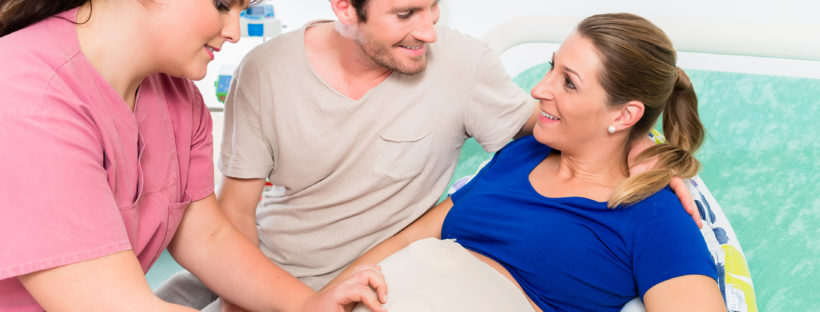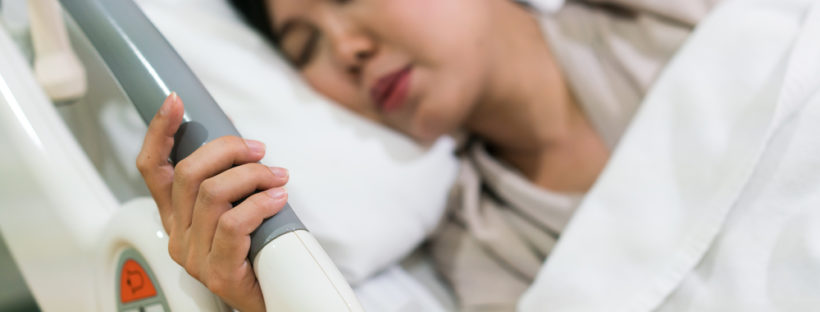Diabetes is a growing epidemic that affects adults and children, including 7.2 million people who are undiagnosed. In 2015, about 9.4% (30.3 million) of Americans had diabetes (Centers for Disease Control and Prevention, 2017). As rates of obesity and type 2 diabetes rise, so does the risk for gestational diabetes mellitus (GDM). While it’s hard to pinpoint the exact prevalence of GDM, estimates suggest that it affects as many as 14% of pregnancies in the United States each year (DeSisto, Kim, & Sharma, 2014).
While the diagnosis of GDM can be scary for moms, it can usually be managed under the care and guidance of their health care team. We recently sat down with Allison Penny, a mother of two who was diagnosed with GDM with both of her pregnancies. We asked Allison questions on how she was able to navigate her diagnosis and what advice she would give to mothers in a similar situation.
How did you feel when you were told you had diabetes with your first pregnancy?
I was surprised, but my healthcare provider assured me it was pretty common. They also told me that the diabetes goes away after the baby is born for most women. When I was diagnosed during my second pregnancy, I was a bit more worried. This pregnancy was unexpected, but thankfully I was already working out and trying to get into shape, and I was able to continue with my workouts. I was definitely more cautious with diet and working out the second time around. My first vaginal birth was complicated and scary, and I think a lot of it had to do with the large size of the baby. Larger babies are a definite risk with GDM.
What concerns did you have following your diagnosis?
By the time I found out, I had been fulfilling all my cravings 🙂 So I had concerns about limiting junk and controlling my diet for both my baby and me.
What did your treatment plan consist of?
I had to measure my sugar first thing in the morning before eating anything. I also had to test my levels 30 minutes after my scheduled meals, like breakfast, lunch, and dinner. While monitoring and tracking my levels, I was able to determine what foods I could eat and which ones I couldn’t. For example, after eating pasta or bread, I found that my levels would elevate. On the other hand, when I ate rice, my levels were at the appropriate number. As a lover of food, I found it frustrating not being able to indulge in cravings and the food that I wanted, but the health of my child was the priority.
Did you have to take medication?
The first time I had GDM, I was able to control my glucose levels with diet. The second time I had it, I had to take pills throughout the rest of my pregnancy. I felt frustrated and defeated that I couldn’t control my glucose levels with diet alone like I had the first time, but later I accepted that pregnancy impacts and changes a woman’s body whether I liked it or not!
Who taught you about what GDM is, about checking your blood sugars, taking any medications?
The doctor, nurses, and nutritionist taught me about GDM. The nutritionist demonstrated how to check blood sugars during my first pregnancy. I opted to not see the nutritionist for the second pregnancy. When I couldn’t control my glucose levels with diet for my second pregnancy, the doctors and nurses explained what dosage to take, how and when to take the medicine, and how it was affecting me.
Did you feel your healthcare providers answered all your questions about diabetes during prenatal visits?
Yes, definitely—during prenatal visits and during labor. Afterward, they didn’t seem to address the diabetes. However, the doctors and nurses regularly pricked my baby girl post-birth to ensure her glucose levels were within a normal range.
Do you have any helpful information or advice for pregnant women who are in your shoes?
Definitely drink a lot of water, and try to exercise daily. Be sure to follow up with your primary care provider after you give birth. Less than 6 months after having my daughter, I went for a routine annual physical and learned that my glucose levels were slightly elevated, among some other health-related and perhaps postpartum-related issues. I also think it’s really important for pregnant moms and nurses to encourage other moms to get themselves thoroughly checked out—bloodwork, EKG, etc.—within a few months of having a baby, because it’s important that moms stay as healthy as possible for their little ones. (See also: Learn These Post-Birth Warning Signs)
You may also be interested in these AWHONN resources:
- Evidence-Based Guideline: Nursing Care of the Woman with Diabetes in Pregnancy covers evidence-based recommendations for care of women with all types of diabetes during pregnancy, labor, birth, and the postpartum Immediate hospital care of the newborn of the woman with diabetes is also covered.
- Enter promotional code DIABETES17 at checkout for a 10% discount (offer valid 11/14 only, expires at 12:00 midnight EST)
- Webinar: Nursing Care of Women with Diabetes During Pregnancy: An Evidence-Based Approach (available in AWHONN’s Online Learning Center—just login and search for the webinar’s title)
- Additional Publications: Manual of High Risk Pregnancy & Delivery, 5th edition describes how to screen for risk factors, provide preventive management, and intervene appropriately when problems arise.
AWHONN Journals:
Healthy Mom&Baby Resources
References & Resources
American College of Obstetrics and Gynecology. (2005, reaffirmed 2016). ACOG practice bulletin. Clinical management guidelines for obstetrician-gynecologists. Number 60, March 2005. Pregestational diabetes mellitus. Obstetrics and Gynecology, 105(3), 675–685.
Centers for Disease Control and Prevention. (2017). National Diabetes Statistics Report, 2017. Atlanta, GA: Centers for Disease Control and Prevention, US Department of Health and Human Services. Retrieved from http://www.diabetes.org/assets/pdfs/basics/cdc-statistics-report-2017.pdf
American College of Obstetrics and Gynecology. (2013). Practice Bulletin No. 137: Gestational diabetes mellitus. Obstetrics and Gynecology, 122(2 Pt. 1), 406–416. doi:10.1097/01.AOG.0000433006.09219.f1
DeSisto, C. L., Kim, S. Y., & Sharma, A. J. (June 19, 2014). Prevalence estimates of gestational diabetes mellitus in the United States, pregnancy risk assessment monitoring system (PRAMS), 2007–2010. Preventing Chronic Disease, 11. doi:10.5888/pcd11.130415
HAPO Study Cooperative Research Group, Metzger, B. E., Lowe, L. P., Dyer, A. R., Trimble, E. R., Chaovarindr, . . . Sacks, D. A. (2008). Hyperglycemia and adverse pregnancy outcomes. New England Journal of Medicine, 358(19), 1991–2002. doi:10.1056/NEJMoa0707943
Gestational diabetes mellitus (GDM) occurs only in pregnant women and means that there is a degree of glucose intolerance during pregnancy. It’s usually diagnosed in the 24th to 28th week of pregnancy.
Diabetes can incur significant morbidity and mortality for the mother, fetus, and newborn into adulthood. Diabetes in all forms is the most common metabolic disease complicating pregnancy (ACOG, 2013). High blood glucose can also result in miscarriage or a stillborn baby (ACOG, 2005). Women who have GDM are also more at risk to develop preeclampsia and or to need a cesarean.
Since GDM can have detrimental results, it’s important that women begin treatment quickly and continue to monitor their sugar levels. Treatment typically includes special meal plans and scheduled physical activity and may also include daily blood glucose testing and/or insulin injections. Concerned moms-to-be should consult their care providers about prevention and treatment of GDM.
 Jennifer Doyle is the 2018 AWHONN President and a women’s health nurse practitioner with nearly 25 years of experience in obstetrics. She is the APN of the Women’s Service Line at Summa Health in Akron, OH, as well as faculty and coordinator of the WHNP program at Kent State University in Kent, OH.
Jennifer Doyle is the 2018 AWHONN President and a women’s health nurse practitioner with nearly 25 years of experience in obstetrics. She is the APN of the Women’s Service Line at Summa Health in Akron, OH, as well as faculty and coordinator of the WHNP program at Kent State University in Kent, OH.



 Shelley Thibeau, PhD, RNC, is the Director of the developing Mothers’ Milk Bank of Louisiana. As a NICU nurse for 38 years, her interest in breastmilk has expanded to exploring breastmilk immunology associated with preterm infant health.
Shelley Thibeau, PhD, RNC, is the Director of the developing Mothers’ Milk Bank of Louisiana. As a NICU nurse for 38 years, her interest in breastmilk has expanded to exploring breastmilk immunology associated with preterm infant health.
 Tasha Poslaniec has been a registered nurse for 17 years. She has been working in obstetrics for over a decade and is currently a Perinatal Quality Review Nurse and Childbirth Educator.
Tasha Poslaniec has been a registered nurse for 17 years. She has been working in obstetrics for over a decade and is currently a Perinatal Quality Review Nurse and Childbirth Educator.
 Karin Beschen is a Licensed Mental Health Counselor specializing in reproductive and maternal mental health. She also serves as a volunteer co-coordinator for Iowa for Postpartum Support International.
Karin Beschen is a Licensed Mental Health Counselor specializing in reproductive and maternal mental health. She also serves as a volunteer co-coordinator for Iowa for Postpartum Support International.
 Amy is an ABSN student at MGH Institute of Health Professions, Boston. She was a stay at home mother for 12 years, a community coordinator for a non profit kids running program and a volunteer at Dana Farber Cancer Institute in Boston before deciding to enter the nursing field. With extensive volunteer experience from a camp for blind & visually impaired adults and children, to co-president of an elementary school PTO, she enjoys working with diverse groups of all ages. Amy aims to work in labor and delivery after graduation in August 2017 but is also interested in global health and epidemiology. She has intentions to keep making a difference in the lives of those she may never meet again.
Amy is an ABSN student at MGH Institute of Health Professions, Boston. She was a stay at home mother for 12 years, a community coordinator for a non profit kids running program and a volunteer at Dana Farber Cancer Institute in Boston before deciding to enter the nursing field. With extensive volunteer experience from a camp for blind & visually impaired adults and children, to co-president of an elementary school PTO, she enjoys working with diverse groups of all ages. Amy aims to work in labor and delivery after graduation in August 2017 but is also interested in global health and epidemiology. She has intentions to keep making a difference in the lives of those she may never meet again.

 Holly Lammer is an Obstetric Nurse, Clinical Educator and Childbirth Instructor for St. Luke’s Health System based in Boise, ID. In addition to teaching credentialed courses through AWHONN and AHA, she develops and teaches curriculum for prenatal and perinatal specialty courses offered in the St. Luke’s system. Holly is also registered with the Yoga Alliance as a 500-hr Yoga Instructor and on faculty as a Prenatal Yoga Teacher Training Instructor. She is certified in Inpatient Obstetrics and Electronic Fetal Monitoring through NCC and is in process of obtaining her Pre and Perinatal Psychology Educator through the Association for Pre and Perinatal Psychology and Health.
Holly Lammer is an Obstetric Nurse, Clinical Educator and Childbirth Instructor for St. Luke’s Health System based in Boise, ID. In addition to teaching credentialed courses through AWHONN and AHA, she develops and teaches curriculum for prenatal and perinatal specialty courses offered in the St. Luke’s system. Holly is also registered with the Yoga Alliance as a 500-hr Yoga Instructor and on faculty as a Prenatal Yoga Teacher Training Instructor. She is certified in Inpatient Obstetrics and Electronic Fetal Monitoring through NCC and is in process of obtaining her Pre and Perinatal Psychology Educator through the Association for Pre and Perinatal Psychology and Health.
 Lizzy Bullock is a swimmer, Red Cross certified swimming instructor (WSI) and swimming coach with over a decade of experience working with infants, children, and adults. Lizzy currently works as a swimming instructor and staff writer for
Lizzy Bullock is a swimmer, Red Cross certified swimming instructor (WSI) and swimming coach with over a decade of experience working with infants, children, and adults. Lizzy currently works as a swimming instructor and staff writer for